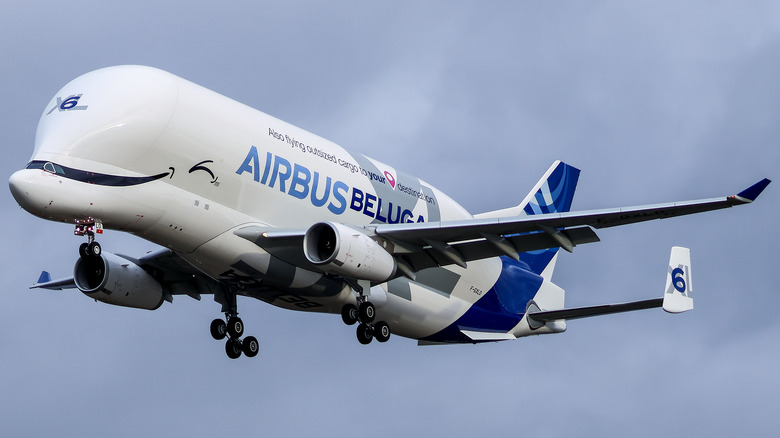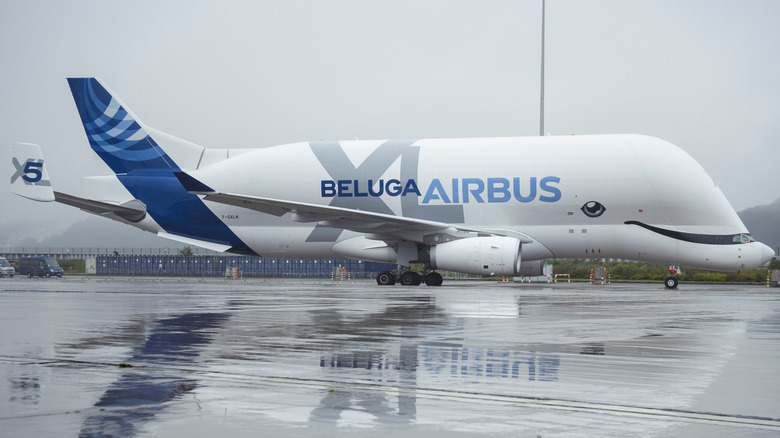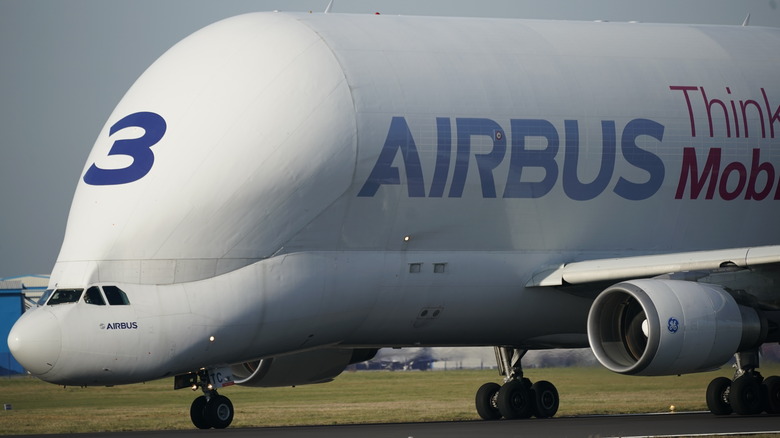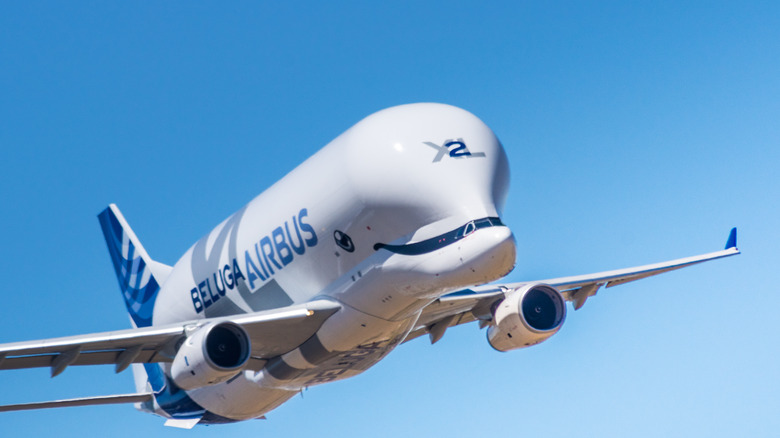How Big Is The BelugaXL Freighter Jet & What's It Used For?
For those who aren't in the aviation industry, it seems there's one unassailable truth: The larger an aircraft is, the more difficult it is to understand how the heck it remains in the air during flights. The most advanced fighter jets employ lightweight materials, aerodynamic bodies, and sophisticated components to keep them airborne and agile, but larger aircraft often look anything but sleek and sophisticated.
According to Guinness World Records, the heaviest aircraft ever built is the AN-225 'MRIYA,' a beast of an aircraft that weighed in at a ludicrous 640 metric tons (1.41 million pounds). In terms of dimensions, meanwhile, the outlet reports that the Stratolaunch is the aircraft with the longest wingspan, measuring 385 feet from wingtip to wingtip. The latter was designed as a transport for space rockets, as was the Mriya (first used for the Soviets' Buran project in the case of the former). For a cargo jet, of course, the key is matching the dimensions and capacity of the aircraft to the size and quantity of the cargo it's intended to transport. The BelugaXL freighter is another iconic model of this type, so named for its beluga whale-esque nose and front end.
Though the Beluga may not quite reach the size of the Stratolaunch or Mriya, it certainly earns its "XL" moniker. Let's see just how big the unique model is and what it was designed to do, as well as a rundown of the history of this beautifully-domed aircraft that was born from the Airbus A300.
The XL Dimensions Of The BelugaXL
Beluga whales, at up to 22 feet long, are formidable creatures indeed, though they're still quite modest in size as whales go; blue whales can reach an absurd 100 feet in length. The crucial difference between Belugas and the BelugaXL, as you'll probably appreciate if you look closely, is that the latter is a freighter created by Airbus and not, in fact, a whale.
The XL debuted in July 2018, with a limited number of them being slated to, as Airbus explained at the time, serve as a larger version of the existing BelugaST models the following year. In terms of their respective dimensions, it's plain that there's no comparison between the two. The ST measures 184 feet long and boasts a wingspan of 147 feet, underlining the fact that the wider Beluga family is a sizable freight-oriented one. The XL, however, went a step further, with a wingspan 50 feet longer than the ST and being 23 feet longer overall.
What is the weight of this vast aircraft? When not laden with fuel (or anything else), it weighs in at 178 tonnes, or metric tons (around the same as the aforementioned blue whale, interestingly). In terms of the highest weight for a safe takeoff, this rises to 227 tonnes. The Boeing 737-800, for comparison, has a max takeoff weight of 175,000 lbs (around 79 tonnes), and is 129 feet and 6 inches long. The Beluga, in short, isn't your typical passenger-ferrier. That isn't its purpose, though, as we'll see next.
What was such a large aircraft designed for?
As its gargantuan dimensions would suggest, the XL was created to carry something significantly larger than passengers. In May 2024, CNN quoted Airbus Beluga Transport's Benoît Lemonnier as noting that the Beluga family's initial purpose was to "transport large sections of Airbus aircraft from its factories in France, Germany, the UK, Spain and Turkey to the final assembly lines located in Toulouse and Hamburg." Typically, Lemonnier went on, it would be necessary to "partially dismantle a payload to make it fit in an aircraft ... whereas in the Beluga, it will just fit."
The family's purpose is clear: It's among the biggest freighters in the world. It isn't the very biggest, though: That was the aforementioned 640-metric ton AN-225, until its destruction in 2022. Nonetheless, the BelugaST, or Super Transporter, was appropriately named; from its first guise, it was an exceptional freighter created for the biggest loads. Airbus boasts that the BelugaXL features storage capacity "big enough to swallow 26 small cars, or seven elephants" — while not many situations may call for a septet of elephants, the XL can serve purposes that other, smaller freighters just aren't equipped to handle.
The model has almost one-third more capacity than the ST, which allows it to carry both wings of an A350 XWB. This particular use is significant in the history of the development of the Beluga family and its evolving purpose, as we'll see in the next slide.
The history of the Beluga family
A freighter this size may seem a bit excessive, but circumstances for Airbus required a small fleet of them as work ramped up. As an international European company (created from a blend of French, Spanish, and German aviation companies in 2000), it was not so easy to collaborate between departments and nations. In this huge-scale business, a transporter of such a huge scale was needed.
The Beluga aircraft family, as we know, derives its name from its unmistakable shape. However, this design is not technically unique. The model is a tweaked and modified version of the A300-600, a far more palatable solution to this issue than the Boeing Stratocruisers (aka the curious Super Guppy) the company had previously been using for the purpose. The A300-600 is a 177 foot, 5 inch jetliner that seats up to 345 in its passenger-accommodating guise, which was adapted to maximize the interior space that could be loaded and better suit this variant's new role.
The ST, as time went on, was shifted to Airbus Beluga Transport, which extends the cargo-carrying capacities to other clients in need of it. Meanwhile, the follow-up model, the even more enormous BelugaXL, was built upon the impressive skeleton of the A330-200. Debuting in July of 2018, this powerful freighter boasts a total of 144,000 lbs of thrust from its dynamic duo of Rolls-Royce Trent 700 turbofans. It's one of the largest and most powerful freighters in the world, and certainly among the most bizarre-looking ones.



